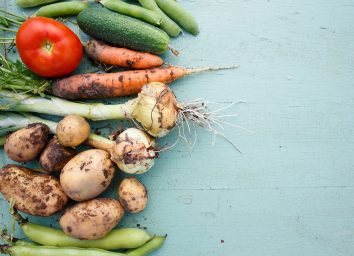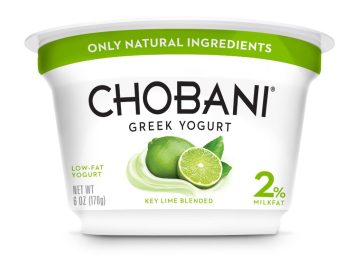When Is GMO-Free a Hoax? Your Guide to Navigating The All-Important (But Sometimes Misleading) Label

These days, labels abound on supermarket packaging: organic, all-natural, vegan, gluten-free, and, of course, non-GMO. And while some of these labels mean quite a lot (like USDA organic or Animal Welfare Approved), others mean, well, nothing at all. (We're looking at you, all-natural.) And yet one is a bit of a tougher nut to crack: GMO vs non-GMO (or GMO-free) and what exactly these labels mean.
Following several years of back-and-forth (and a landmark move from Vermont legislators), in 2016, a law was finally passed forcing the USDA to enforce GMO labeling nationwide. However, standards have yet to be introduced into the marketplace (and won't be until 2022), and the marketplace is now quite murky. But however you look at it, non-GMO labeling isn't all it seems.
GMO vs. non-GMO: what do the labels actually mean?
But before we get into the nitty-gritty of labeling, let's start with the big question—what is GMO and non-GMO labeling, and why should you care? Well, for starters, GMO stands for genetically modified organisms. While most experts agree that there's nothing intrinsically unsafe about genetically modified organisms, there are a few innate things to consider about these foods. Most genetically modified foods on the U.S. market are engineered for a specific reason: to help with pest and weed management. This can be done in a number of ways, but the two most common are either engineering foods to resist weedkillers—such as glyphosate, the key ingredient in the common weedkiller Bayer's Roundup—or genetically engineering foods to produce their own pesticides, such as Bt corn.
In the case of the former, the GMO crop is engineered to be able to withstand heavy doses of glyphosate, which means that they are sprayed liberally and residues are found in the foods we eat. Because the World Health Organization dubbed glyphosate a probable human carcinogen in 2015, and traces of glyphosate have been found in the U.S. food supply in everything from breakfast cereal to wine, this is a good reason to opt for non-GMO foods.
In the case of Bt corn, a slightly different mechanism is at play. Genes from Bacillus thuringiensis, a soil bacterium toxic to invasive pests, are spliced directly into the genome of corn, essentially allowing the plant to produce its own pesticide. But because Bt corn is so widely planted throughout the U.S., it has led to widespread pesticide resistance, and some experts even posit that it could be dangerous to humans.
There are also other risk factors to consider. The sale of GMO seeds reduces natural biodiversity in the soil and gets farmers caught in a cycle of applying chemicals to their crops that is difficult to escape. Genetic modification can even bring about off-target effects. But while you may want to avoid GMOs, looking for the label might not necessarily mean what you think it means.
Here are three times the non-GMO label doesn't actually carry much weight and can be misleading:
When it's on an organic product.
If you see a product sporting dozens of labels—and two of them are organic and non-GMO—that's like saying something is both a square and a rectangle. USDA organic standards preclude the inclusion of GMOs in a certified product, so if a product already has the organic label, it doesn't need the non-GMO label for you to know it's already devoid of GMOs.
"Simply put, if it's a USDA certified organic product, it's non-GMO," says Steve Taormina, Business Unit Manager for NSF International's Consumer Values Verified Program.
When it's on a product that couldn't feasibly contain GMOs.
You'll see non-GMO labels on everything from bananas to water these days, but that doesn't mean much, seeing as there are only 13 different GMO crops available in the U.S. today.
The Non-GMO Project has categorized 10 of these crops as "high-risk," as they are commercially available to consumers:
Apple and salmon will soon make this an even dozen, as they will soon be available on the American market. Wheat, while not commercially available in GMO form, has been found to contaminate non-GMO wheat farms, and therefore rounds out the list of major things to watch for.
Taormina explains, though, that while EU and USDA regulations do not require labeling on products derived from animals fed GMO feeds, The Non-GMO Project does include them, as they pose some of the same problems as GMO crops, particularly with regards to the environmental impact of genetic engineering. If you fall in with The Non-GMO Project definition, then, GMOs could also be present in products such as eggs, milk, and meat.
Admittedly, this shortlist actually becomes quite a long one when you consider the omnipresence of the above ingredients in the American food system, particularly in processed food. Hans Eisenbeis, Director of Marketing & Communications at The Non-GMO Project, notes that not only is every sugar beet grown in the U.S. a GMO sugar beet, but soy and corn can be present in oil or syrup form in a variety of goods—and even in ink or plastics used for packaging.
"In your average grocery store, about 80 percent of all the groceries are going to contain some GMO derivative," says Eisenbeis.
That said, for anything that's not on this list—especially whole foods in the produce aisle—there's no need to seek out a label. If it doesn't contain one of the danger zone ingredients, there's no way it could contain GMOs.
When it's simply down to splitting hairs.
Currently, the United States differentiates between two different genetic engineering techniques: transgenic modification and gene editing. In the case of the former, a scientist splices a gene from another species into the genome of a crop or animal, for example, Bt corn or AquAdvantage salmon, which is engineered by splicing genes from Chinook salmon and ocean pout in order to create a salmon that grows twice as fast on less food.
Newer techniques, meanwhile, rely on gene editing, which is when parts of the genome of a crop are modified or deleted without relying on the genome of another species. As far as the EU and the UN are concerned, both are classed as a genetic modification; in the U.S., however, only the former is recognized as GMO.
"Basically, the new labeling law is looking at GMOs in a really simplified way," says Eisenbeis.
Experts claim that gene-editing technology is less dangerous than traditional genetic modification, but Eisenbeis doesn't agree, because examples of gene pollution and off-target effects have already occurred using these more modern techniques.
Once the new federal law comes into effect, a product such as a new gene-edited soy oil, which is engineered in a lab to have greater stability and no trans fat, could be labeled non-GMO despite having been made using gene-editing technology. Only a product sporting the Non-GMO Project label will be devoid of both older transgenic and newer gene-editing techniques.
Non-GMO labeling is certainly murky, but armed with the right tools, you can make informed decisions about what you want to feed yourself and your family.








